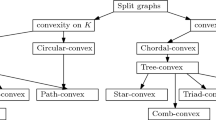Abstract
Given a vertex-weighted tree T, the split of an edge xy in T is min{s x , s y } where s x (respectively, s y ) is the sum of all weights of vertices that are closer to x than to y (respectively, closer to y than to x) in T. Given a set of weighted vertices V and a multiset of splits S, we consider the problem of constructing a tree on V whose splits correspond to S. The problem is known to be NP-complete, even when all vertices have unit weight and the maximum vertex degree of T is required to be no more than 4. We show that
-
the problem is strongly NP-complete when T is required to be a path. For this variant we exhibit an algorithm that runs in polynomial time when the number of distinct vertex weights is constant.We also show that
-
the problem is NP-complete when all vertices have unit weight and the maximum degree of T is required to be no more than 3, and
-
it remains NP-complete when all vertices have unit weight and T is required to be a caterpillar with unbounded hair length and maximum degree at most 3.
Finally, we shortly discuss the problem when the vertex weights are not given but can be freely chosen by an algorithm.
The considered problem is related to building libraries of chemical compounds used for drug design and discovery. In these inverse problems, the goal is to generate chemical compounds having desired structural properties, as there is a strong correlation between structural properties, such as the Wiener index, which is closely connected to the considered problem, and biological activity.
The authors acknowledge the support of Conicyt Chile via projects Fondecyt 11090390 (M.L., K.S.), Fondecyt 11090141 (M.S.), Anillo ACT88 (K.S.), and Basal- CMM (S.G., M.S., K.S.). The first author acknowledges partial support from the European Research Council (COMPLEX REASON, 239962). The second and fourth authors acknowledge the support of the French Agence Nationale de la Recherche (ANR AGAPE ANR-09-BLAN-0159-03).
Access this chapter
Tax calculation will be finalised at checkout
Purchases are for personal use only
Preview
Unable to display preview. Download preview PDF.
Similar content being viewed by others
References
Aoki-Kinoshita, K.F., Kanehisa, M., Kao, M.-Y., Li, X.-Y., Wang, W.: A 6-Approximation Algorithm for Computing Smallest Common Aon-Supertree with Application to the Reconstruction of Glycan Trees. In: Asano, T. (ed.) ISAAC 2006. LNCS, vol. 4288, pp. 100–110. Springer, Heidelberg (2006)
Balaban, A.T.: Chemical Applications of Graph Theory. Academic Press, Inc. (1976)
Bonchev, D., Rouvray, D.H.: Chemical Graph Theory: Introduction and Fundamentals. Taylor & Francis (1991)
Dobrynin, A.A., Entringer, R., Gutman, I.: Wiener index of trees: Theory and applications. Acta Applicandae Mathematicae 66(3), 211–249 (2001)
Downey, R.G., Fellows, M.R.: Parameterized complexity. Springer, Heidelberg (1999)
Faulon, J.-L., Bender, A.: Handbook of Chemoinformatics Algorithms, 1st edn. Chapman and Hall/CRC (2010)
Fellows, M.R., Gaspers, S., Rosamond, F.A.: Parameterizing by the Number of Numbers. In: Raman, V., Saurabh, S. (eds.) IPEC 2010. LNCS, vol. 6478, pp. 123–134. Springer, Heidelberg (2010)
Flum, J., Grohe, M.: Parameterized Complexity Theory. Texts in Theoretical Computer Science. An EATCS Series. Springer, Berlin (2006)
Garey, M.R., Johnson, D.S.: Computers and Intractability, A Guide to the Theory of NP-Completeness. W.H. Freeman and Company, New York (1979)
Gillet, V.J., Willett, P., Bradshawand, J., Green, D.V.S.: Selecting combinatorial libraries to optimize diversity and physical properties. Journal of Chemical Information and Computer Sciences 39(1), 169–177 (1999)
Goldman, D., Istrail, S., Lancia, G., Piccolboni, A., Walenz, B.: Algorithmic strategies in combinatorial chemistry. In: SODA, pp. 275–284 (2000)
Hammer, P.L. (ed.): Special issue on the 50th anniversary of the Wiener index. Discrete Applied Mathematics, vol. 80. Elsevier (1997)
Hulett, H., Will, T.G., Woeginger, G.J.: Multigraph realizations of degree sequences: Maximization is easy, minimization is hard. Operations Research Letters 36(5), 594–596 (2008)
Komusiewicz, C., Niedermeier, R., Uhlmann, J.: Deconstructing Intractability: A Case Study for Interval Constrained Coloring. In: Kucherov, G., Ukkonen, E. (eds.) CPM 2009 Lille. LNCS, vol. 5577, pp. 207–220. Springer, Heidelberg (2009)
Li, X., Zhang, X.: The edge split reconstruction problem for chemical trees is NP-complete. MATCH Communications in Mathematical and in Computer Chemistry 51, 205–210 (2004)
Niedermeier, R.: Invitation to Fixed-Parameter Algorithms. Oxford Lecture Series in Mathematics and Its Applications. Oxford University Press, Oxford (2006)
Sheridan, R.P., Kearsley, S.K.: Using a genetic algorithm to suggest combinatorial libraries. Journal of Chemical Information and Computer Sciences 35(2), 310–320 (1995)
Trinajstić, N.: Chemical Graph Theory, 2nd edn. CRC Press (1992)
Wiener, H.: Structural determination of paraffin boiling points. Journal of the American Chemical Society 69(1), 17–20 (1947)
Author information
Authors and Affiliations
Editor information
Editors and Affiliations
Rights and permissions
Copyright information
© 2011 Springer-Verlag Berlin Heidelberg
About this paper
Cite this paper
Gaspers, S., Liedloff, M., Stein, M., Suchan, K. (2011). Complexity of Splits Reconstruction for Low-Degree Trees. In: Kolman, P., Kratochvíl, J. (eds) Graph-Theoretic Concepts in Computer Science. WG 2011. Lecture Notes in Computer Science, vol 6986. Springer, Berlin, Heidelberg. https://doi.org/10.1007/978-3-642-25870-1_16
Download citation
DOI: https://doi.org/10.1007/978-3-642-25870-1_16
Publisher Name: Springer, Berlin, Heidelberg
Print ISBN: 978-3-642-25869-5
Online ISBN: 978-3-642-25870-1
eBook Packages: Computer ScienceComputer Science (R0)




